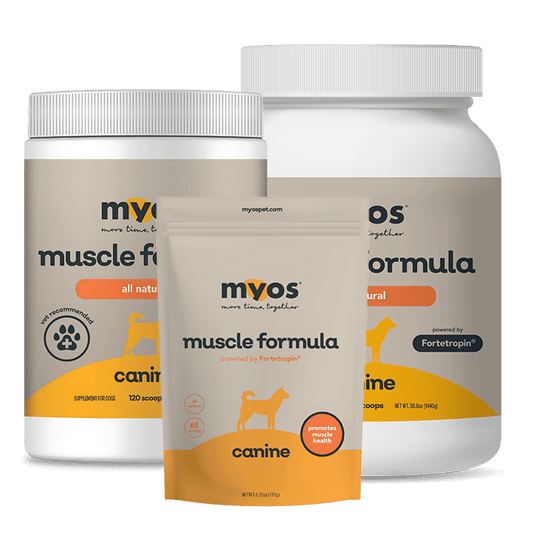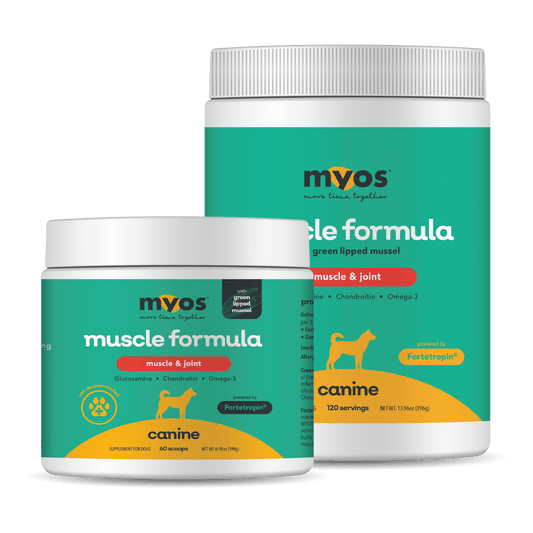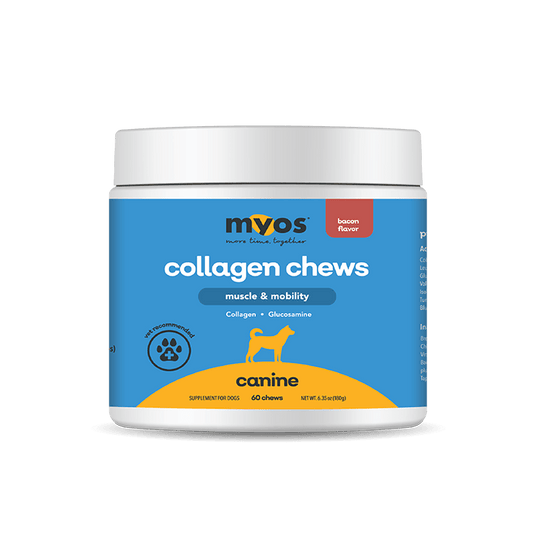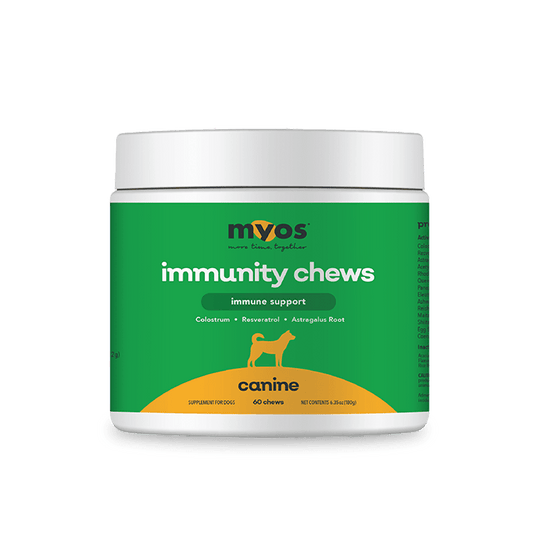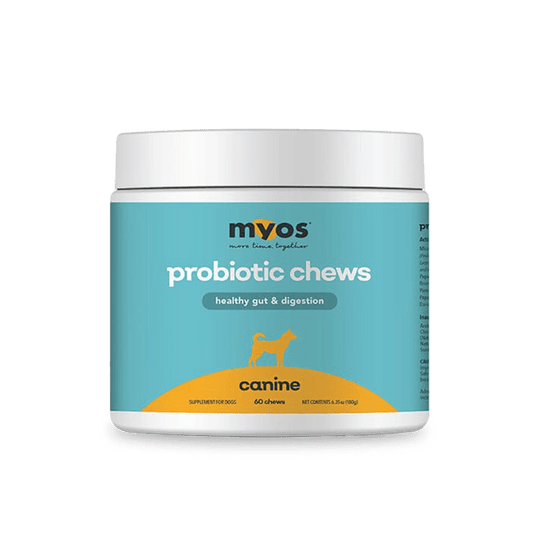By Neerav D. Padliya, Ph.D.
Background: The Impact of Muscle Loss
Sarcopenia, commonly known as age-related muscle loss is a very active area of research among Geriatricians, Gerontologists and Public Health Experts. Sarcopenia can significantly impact the quality of life for humans due to its impact on mobility, often measured by clinicians using gait speed [1]. A human clinical study by researchers at the Karolinska Institute, Sweden have concluded that sarcopenia is associated with elevated mortality risk in men when considering all causes [2]. Similar trends related to sarcopenia were observed in women with non-metastatic breast cancer in a Harvard study examining the impact of body composition on breast cancer survival [3].
Sarcopenia in cats and dogs has been reviewed by Freeman [4,5]. Researchers at École nationale vétérinaire d'Alfort (ENVA), France have studied the impact of frailty on mortality risk in Golden Retriever and Labrador Retriever dogs. Sarcopenia is one of the major causes of frailty and elevated frailty-related phenotype (FRP) was shown to be associated with increased mortality risk in these dogs [6]. While the ENVA study focused on the impact of FRP on mortality risk in dogs, a clinical trial conducted by Researchers at the Swedish University of Agricultural Sciences and the University of Cambridge [7,8] discussed in detail below focused on the impact of body composition on survival in Labrador Retriever dogs.
Clinical Trial in Labrador Retriever Dogs: Impact of Body Composition on Survival
The clinical trial outlined in Figure 1 and briefly described earlier was sponsored by Proctor & Gamble to examine the impact of diet, food portion size and the supplement, mannoheptulose (MH) on longevity [7]. A subsequent paper [8] published based on this original study focused on the longitudinal study analysis that was conducted on the N=39 dogs described in Figure 1.
One of the interesting features of this study is that it included 11 calendar years of Dual-Energy X-ray absorptiometry (DEXA) scans for body composition analysis. Monitoring changes in body composition over the life of the dog enabled the researchers to understand how body composition impacts survival of Labrador Retrievers. DEXA scans were collected at ages ranging from 6.2 years to 17 years.
It is clear from Figure 2 that dogs with increased lean mass as a function of age at 10 years and beyond had improved survival. Dogs with exceptional survival (orange line) had the highest percentage of lean body mass on average at 10 years of age. Dogs in the expected survival category (red line) had the lowest percentage of lean body mass on average at 10 years of age. Dogs in the long-lived category (white line) had an average percentage of lean body mass at 10 years of age that fell between the exceptional and expected categories. Dogs with the highest percentage of lean body mass at 10 years of age managed to live as long as 17 years.
Figure 1: An outline of a clinical study that examined the impact of body composition on survival in Labrador Retriever dogs [7,8]. Image reproduced from [7].

Figure 2: Polynomial smooth plot of average percent lean (95% CI) as a function of age for each longevity category: expected (red line), long-lived (white line) and exceptional (orange line). Reproduced from [8].

Fortetropin®: Advanced Nutrition to Address Muscle Loss in Dogs
Fortetropin® is an advanced nutrition product made from fertilized chicken egg yolk using a patented, low temperature manufacturing process [9,10] that helps to better retain the natural bioactivity of the proteins, peptides and lipids that are found to be present within fertilized, chicken egg yolk. In human clinical studies, Fortetropin® has been shown to increase the rate of muscle protein synthesis [11] and lead to gains in muscle mass and strength [12].
In a randomized, double blind, placebo-controlled study involving 100 dogs recovering from TPLO surgery conducted at Kansas State University, daily consumption of Fortetropin® led to reduced muscle atrophy and improved recovery in dogs [13]. A follow up clinical study is currently underway to examine the impact of Fortetropin® on quality of life and mobility on geriatric dogs at Kansas State University.
Learn more about how Fortetropin® can make a difference for aging dogs at www.myospet.com.
References
- Fielding, Roger A., et al. "Sarcopenia: an undiagnosed condition in older adults. Current consensus definition: prevalence, etiology, and consequences. International working group on sarcopenia." Journal of the American Medical Directors Association4 (2011): 249-256.
- Ruiz, Jonatan R., et al. "Association between muscular strength and mortality in men: prospective cohort study." Bmj337 (2008): a439.
- Caan, Bette J., et al. "Association of muscle and adiposity measured by computed tomography with survival in patients with nonmetastatic breast cancer." JAMA oncology6 (2018): 798-804.
- Freeman, L. M. "Cachexia and sarcopenia: emerging syndromes of importance in dogs and cats." Journal of veterinary internal medicine1 (2012): 3-17.
- Freeman, Lisa M. "Cachexia and Sarcopenia in Companion Animals: An Under‐Utilized Natural Animal Model of Human Disease." JCSM Rapid Communications2 (2018): 1-17.
- Hua, Julie, et al. "Assessment of frailty in aged dogs." American journal of veterinary research12 (2016): 1357-1365.
- Adams, Vicki Jean, et al. "Exceptional longevity and potential determinants of successful ageing in a cohort of 39 Labrador retrievers: results of a prospective longitudinal study." Acta Veterinaria Scandinavica1 (2015): 29.
- Penell, Johanna Christina, et al. "Body weight at 10 years of age and change in body composition between 8 and 10 years of age were related to survival in a longitudinal study of 39 Labrador retriever dogs." Acta Veterinaria Scandinavica1 (2019): 42.
- Buxmann, Waldermar, et al. “Process for producing a composition for increasing muscle mass.” S. Patent # 10,165,785, Issue Date: January 1, 2019.
- Buxmann, Waldermar, et al. “Process for producing a composition containing active follistatin.” S. Patent #8,815,320, Issue Date: August 26, 2014.
- Evans, William J., et al. “Effects of Fortetropin® on the rate of muscle protein synthesis in older men and women: a randomized, double blinded, placebo-controlled study.” Gerontol Med Sci, submitted.
- Sharp, Matthew H., et al. "The effects of fortetropin supplementation on body composition, strength, and power in humans and mechanism of action in a rodent model." Journal of the American College of Nutrition8 (2016): 679-691.
- White, Dana A., et al. "Fortetropin inhibits disuse muscle atrophy in dogs after tibial plateau leveling osteotomy." PloS one4 (2020): e0231306.

